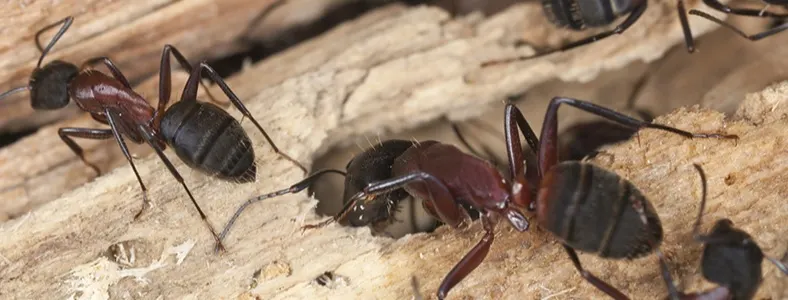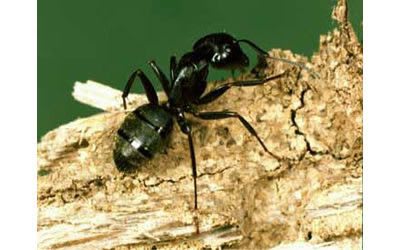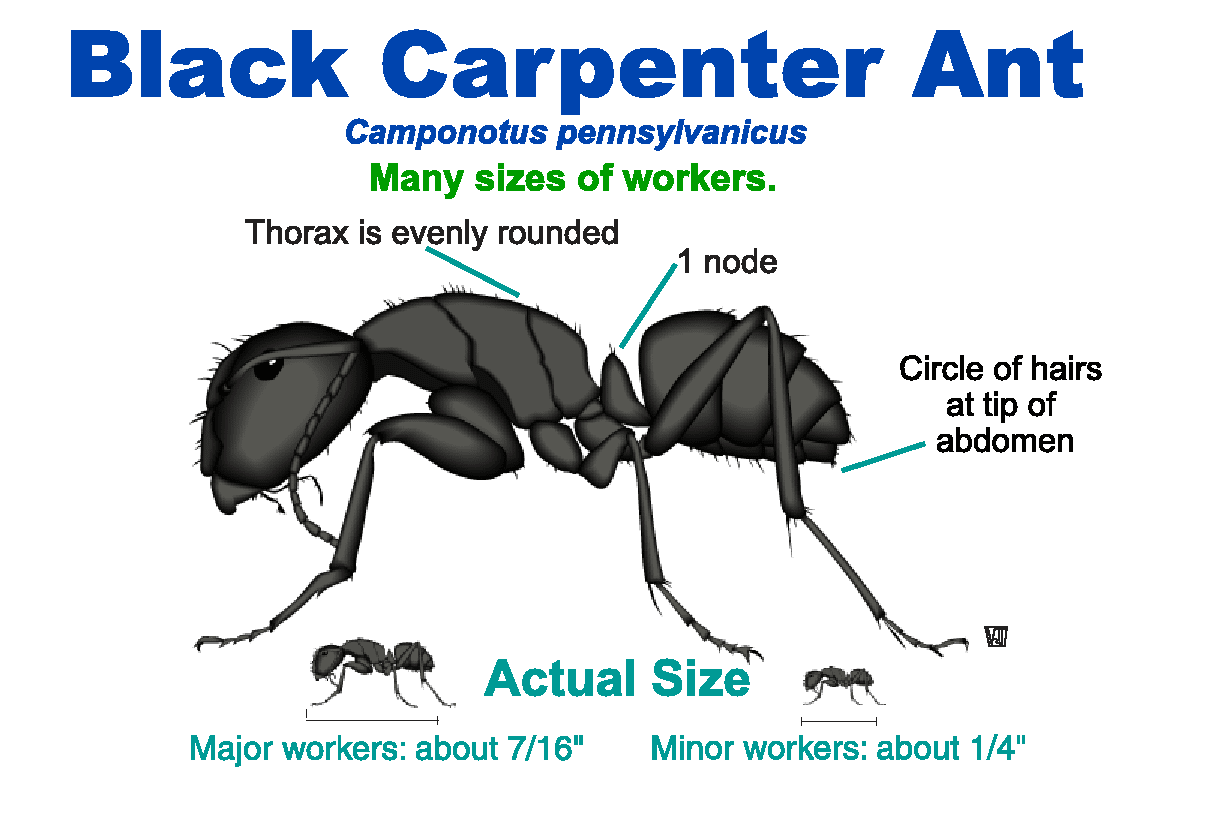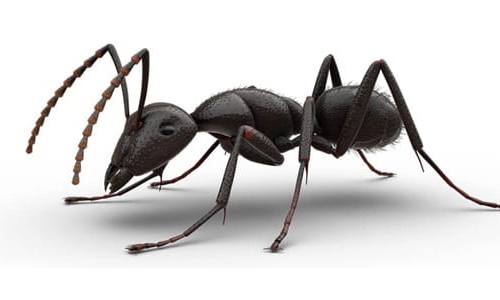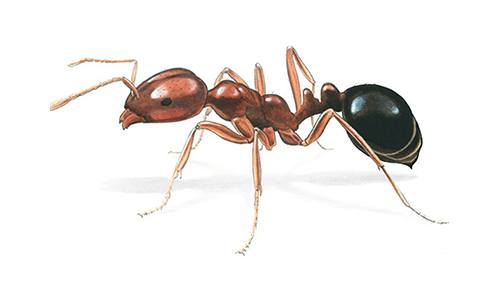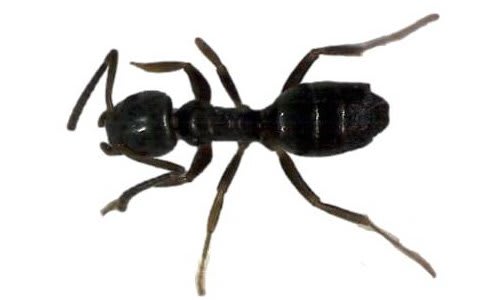
Black Carpenter Ant Biology & Habits
Get rid of black carpenter ants by understanding carpenter ants and their biology. Keep reading to learn about carpenter ant sizes, ant colony behaviors, and the best ant control products.
December 16th, 2023
Get Rid Of
Carpenter Ant Control Product Recommendations
Due to the black carpenter ant’s size, it is a good idea to use ant bait and ant nest voids to treat an ant infestation and control carpenter ants.
Ant Bait
Maxforce Fleet Ant Bait
Maxforce Fleet is a carbohydrate-based Fipronil gel with a high moisture content that kills black carpenter ants in 3-5 days. Apply Maxforce Fleet in small amounts with the syringe applicator or bait injector where you notice ants running. Since ants are nocturnal, applying the Maxforce fleet in the evening is a good tactic to catch them when they emerge at night.
Advance 375A Ant Bait Gel
The Advance 375 A Ant Bait is a protein-based product that targets blank carpenter ants that have a love for starchy foods. Florida carpenter ants are commonly found indoors, particularly in the kitchen and behind dishwashers. Apply Advance 375A ant bait in hard-to-reach areas such as sinks, windows, or doorframes to get rid of these pesky creatures.
Carpenter Ant Bait Combo
This kit contains both Maxforce Fleet and Advance 275A to kill carpenter ants. If you want to prevent a carpenter ant infestation, apply both products to any visible ant trails inside and outside.
Treating the Black Carpenter Ant Colony & Nesting Sites
Apply Dust Into Void Areas
In nesting sites, D Fense dust should be bolstered into the colonies as dust. For the best results, apply using a duster.
Apply Aerosols Into Void Areas
Both Spectre PS Aerosol and Alpine Aerosols have crack and crevice tips and are non-repellent insecticides. They operate well inside areas where black carpenter nesting sites are difficult to find. The aerosols will enter the hole and treat the entire colony of black carpenter ants.
Use Aerosol Foam In Void Areas
Foam pesticides like Fuse Foam and Alpine Foam are non-repellent. Fuse Foam foams into ant and termite nests, galleries, and structural cavities with a 30:1 expansion ratio. It's ideal for going into hard-to-reach spaces.
Identify
To treat a carpenter ant infestation successfully, it is important that you correctly identify the type of ants you are dealing with. Is it the larger black carpenter ant, or the smaller, reddish Florida carpenter ant? With proper identification, you will be able to effectively prevent and get rid of carpenter ants for good.
Identify
Inspect
Get Rid of Carpenter Ants
Prevent
Carpenter Ants vs Black Ants
Carpenter ants are a group of ant species belonging to the Camponotus genus. Many people confuse carpenter ants and black ants when in fact, they are the same. Camponotus pennsylvanicus, or the black carpenter ant, is one of the most adaptable ants in its genus and is often referred to as ‘black ants’ due to its defining color.
How Big are Carpenter Ants? | Carpenter Ants Size
The large size and uniform black color of carpenter ants and black ants make them easy to recognize. Each ant colony contains the queen, as well as major, media, and minor workers, who all vary in size and shape. Florida carpenter ants are another family of the black carpenter ant, belonging to the Camponotus genus. Workers are a little smaller in size.
Worker Ants
Major, media, and minor workers: 6 to 13 mm (1/4 to 1/2 inch) in length. Florida worker ants are slightly smaller, 4.2 to 4.7 mm (3/16 to 3/18 inches) in length.
Queen: Large, over 1/2 inch in length, with a little head and large abdomen.
Black Carpenter Ants
Eastern United States: (Camponotus pennsylvanicus)
Western United States (Camponotus modoc) (Camponotus vicinus)
Color: Black color body with red and black legs
Swarming: Colony matures in 3–4 years, swarming occurs in late spring–summer
Distribution: Mid-West to Eastern States
Colony size: Up to 15,000 workers
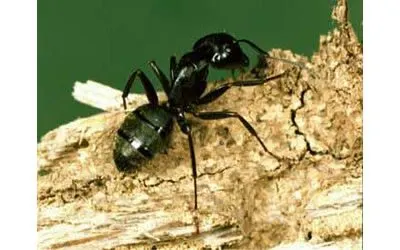

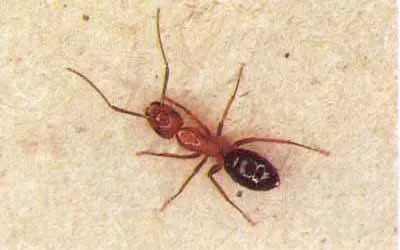
Florida Carpenter Ants
Various Florida Carpenter Ant Types
Eastern United States: (Camponotus abdominalis floridanus)
Color: Red head with a black abdomen, thorax, and legs
Swarming: Unmated swarmers in satellite colonies
Distribution: Florida and Southeast U.S.
Colony Size: Up to 3,500 workers.
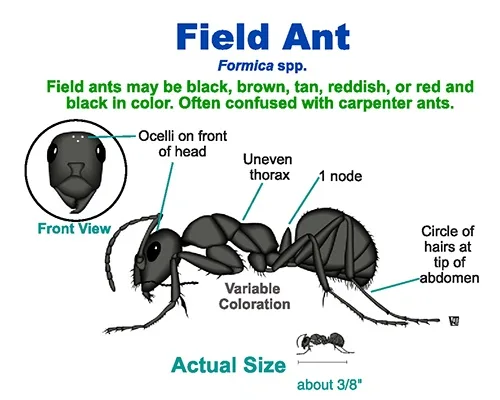
Field Ants (Not to be confused with the Carpenter Ant)
Field Ant (University of Nebraska)
The Field Ant (Formica) may be identified as a carpenter ant and is found throughout the USA. Both carpenter ants and field ants have one node or a one-segmented waist. The field ants have an uneven thorax, and the carpenter ants have an evenly rounded thorax.
Field ants may come inside to forage but do not establish nests inside like carpenter ants. Their nesting sites are in the soil, moist wood, or tree stumps, and construct their nest from grass stems, twigs, or pine needles. Their nests appear as low-profile mounds in the yard. Their mounds can reach a foot or more in diameter.
If the mound is disturbed, the black ants may aggressively swarm out and bite the intruder. During the fall months, they are commonly noticed as they swarm from underground to new locations to establish new colonies.
Field ant infestations are different from carpenter ant infestations. In the case of field ants, use an ant bait granular around the mound like Maxforce Complete Ant Bait.
Inspect
Carpenter Ant Colony Habits
Each carpenter ant colony consists of a queen as well as major, media, and minor workers. Carpenter ants construct two different kinds of nests: parent and satellite colonies. Parent colonies, when mature, contain an egg-laying queen, a brood, and 2,000 or more worker ants. Satellite nests may have large numbers of worker ants but contain no queen, eggs, or larvae. The carpenter ants inside your home may come from satellite nests or the parent colony.
Inspecting for a Carpenter Ant Nest
For example, the carpenter ants found in your home may have originated from parent nests outdoors, perhaps in a tree stump or decayed wood. Black ants can also find their way into your home by climbing along tree branches that directly touch your house. These ants could also come from one or more satellite nests hidden behind a wall in the kitchen or bathroom, or perhaps from wood dampened by a roof leak in the attic.
Swarming is the process by which black carpenter ants leave the colony to reproduce and establish new colonies on their own, called satellite nesting sites. Male ants with wings are most sensitive to environmental conditions such as temperature and sunlight hours. When it’s warm and sunny, it indicates that it is time to swarm. In this process, the winged males emit a chemical that encourages the female to abandon the carpenter ant nest.
Winged ants form from pupae in May to August in the Eastern United States and in February to June in the West.
Satellite nesting sites emerge both indoors and outdoors once the parent colony has matured over several years.
Foraging winged ants can travel up to 100 yards from their nest to find food.
Carpenter Ant Eggs
In a parent ant colony, one wingless queen is active and responsible for laying “eggs” or pupae. Carpenter ants go through complete development (egg, larva, pupa, adult). Pupae are often called carpenter “ant eggs” because they are encased inside cocoons.
Carpenter ant eggs, or pupae, have a white, oval-shaped appearance and are small inside. If you discover carpenter ant eggs inside your home, this is an indicator of a much larger infestation than it may appear.
Carpenter Ant Diet
Outdoors, carpenter ants feed on protein-based foods (such as living and dead insects) and sweet-based foods (such as the honeydew produced by aphids and certain scale insects). Indoors, carpenter ants feed on meat and fats, and any sweet food such as syrups and jellies.
Are Ants Nocturnal?
Carpenter ants are nocturnal. Foraging black carpenter ants are both diurnal and nocturnal. They prefer to hollow out and build nests in softened wood, such as moist or partially decayed wood. Unlike termites, carpenter ants do not eat wood. Instead, the ants form galleries that have a sandpaper appearance.
In comparison, termite tunnels are rough-looking. Wood that has been damaged by carpenter ants contains no mud-like material, as is the case with termites.
Key Takeaway
Carpenter ant food-gathering workers are most active just after dark. Although large carpenter ant colonies can cause structural damage, the damage is not normally as serious as termite damage. Carpenter ant workers do not eat the wooden structures as termites do.
Prevent
Carpenter Ant Infestation Prevention
Keeping interior and exterior wood structures dry is the best approach to prevent a black carpenter ant infestation from occurring and damaging your home.
To avoid future carpenter ant infestations, follow the instructions below:
Moisture issues, roof leaks, and plumbing leaks should all be addressed.
Examine tree stumps, dead trees, and decayed wood for any hidden black carpenter ant nests.
Seal foundation cracks and openings where ants may enter, especially where utility pipes and wires enter from the outside.
Stack firewood away from the home, if possible, elevated off the ground. Black carpenter ants love to make their build nests in firewood.
Please contact us for more information and assistance with your carpenter ant problem. 1-800-476-3368
Non-Repellent Insecticide Sprays to Prevent Carpenter Ants
Spraying Procedures for Foraging Carpenter Ants
Foraging ants will occasionally enter your home, find a food supply, and then return to their satellite nests. A perimeter treatment with a non-repellent residual pesticide like Navigator SC will keep these foraging ants away and kill carpenter ant eggs. If the queen can't lay eggs, the colony will die out. Termidor SC is also effective against Termites, Spiders, Roaches, Centipedes, Millipedes, Ticks, and other insects.
Carpenter Ant Behavior and Types
Get rid of carpenter ants by understanding carpenter ant types and behavior.
Black Carpenter Ants
Eastern United States: (Camponotus pennsylvanicus)
- Color: All black Workers: 1/4–1/2-inch in size
- Queen: Large, over 1/2-inch in size
- Swarming: Colony matures in 3–4 years, swarming occurs in late spring–summer
- Distribution: Mid West to Eastern States
Western United States (Camponotus modoc) (Camponotus vicinus)
- Color: Black Body, red dark legs
- Workers: 1/5–1/2-inch in size, but variable Queen: Large, over 1/2-inch in size
- Swarming: Occurs in late spring–summer.
- Colony size: Up to 15,000 workers
- Distribution: Western US States Nests: Generally excavates in decayed or damaged wood. Creates smooth tunnels and galleries.They can compromise structural integrity by expanding into sound wood. Nests may be found in dead trees and stumps outside.
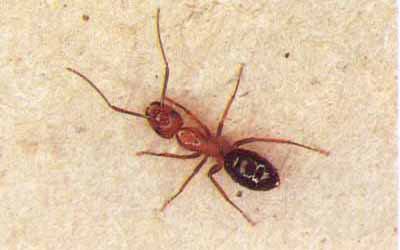
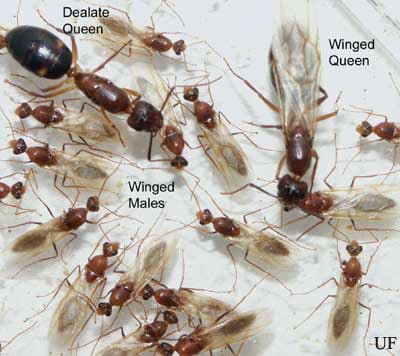
Florida Carpenter Ants
Eastern United States: (Cabdominalis floridanus))
- Color:Red head, black abdomen, thorax, and legs Workers: Smaller, 3/16–3/8-inches in size
- Queen: Large, over 1/2-inch in size
- Unmated swarmers in satellite colonies
- Distribution: Florida and southeast U.S.
- Colony Size:Up to 3,500 workers.
- Nests:Seeks to nest in existing voids or excavates soft woods that are rotten and styrofoam.
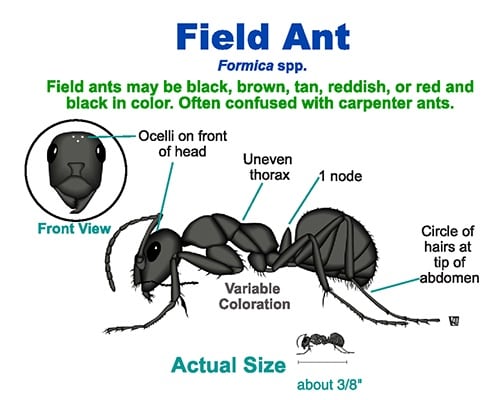
Field Ants (Not to be confused with the Carpenter Ant)
The Field Ant (Formica) may be identified as a carpenter ant and are found throughout the USA. Both carpenter ants and field ants have one node or a one-segmented waist. The field ants have an uneven thorax, and the carpenter ants have an evenly rounded thorax.
Field ants may come inside to forage but do not establish nests inside like the carpenter ant. They nest in soil or decayed logs and construct their nest from grass stems, twigs, pine needles, etc., forming a mound.
They form low-profile mounds in the yard. Their mounds can reach a foot or more in diameter. If the mound is disturbed, they may aggressively swarm out and bite the intruder. The bite may sting. During the fall months, they are commonly noticed as they swarm from underground to new locations to establish new colonies. Use an ant bait granular around the mound like Maxforce Complete Ant Bait.
Carpenter Ant Diet
Outdoors, carpenter ants feed on protein-based foods (such as living and dead insects) and sweet-based foods (such as the honeydew produced by aphids and certain scale insects). Indoors, carpenter ants feed on meat and fats, and any sweet food such as syrups and jellies.
Carpenter Ant Habits
Carpenter ants are nocturnal. They prefer to hollow out their nests in softened wood, such as moist or partially decayed wood. Their nests are called galleries. These galleries are clean and have a sandpaper appearance.
In comparison, termite galleries are rough-looking. Wood that has been damaged by carpenter ants contain no mud-like material, as is the case with termites.
Florida Carpenter Ant nests are commonly found indoors in such places as the moist, hollow wall void behind dishwashers. Nests are usually found in areas where water leakage could occur, such as around bathtubs, sinks, roof leaks, poorly-flashed chimneys, or poorly sealed windows or door frames. Outdoor nests are found in places like tree stumps, hollow logs, fence posts, or dead portions of standing trees. However, these persistent creatures have even been known to build nests in cracks and crevices of sound wood.
Carpenter ants may establish nests in several different locations. It is important to understand that you can have both inside and outside nests. Carpenter ants construct two different kinds of nests: parent and satellite colonies.
Parent colonies, when mature, contain an egg-laying queen, a brood, and 2,000 or more worker
Ants. Satellite colonies may have large numbers of worker ants but contain no queen, eggs, or larvae. For example, the ants found in your home may have originated from parent nests outdoors,
perhaps in a tree stump, timber, or woodpile, or from one or more satellite nests hidden behind a wall in the kitchen or bathroom, or perhaps from wood dampened by a roof leak in the attic. Although large carpenter ant colonies can cause structural damage,
the damage is not normally as serious as termite damage.
Often, the ants you see inside your home are simply foraging for food, and you may not see large numbers of them. Foraging workers can travel 100 yards from nest to food and can be found wandering throughout your house.
Key Takeaway
Carpenter ant food gathering workers are most active just after dark.
Carpenter Ant Control Product Recommendations
Written by our resident pest control expert Ken Martin.




